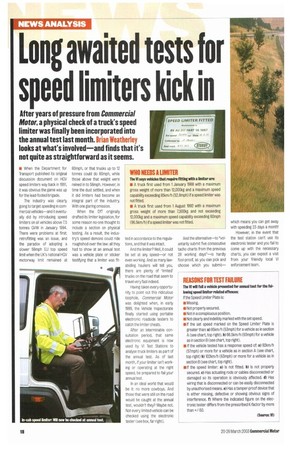Long awaited tests for speed limiters kick in
Page 18

If you've noticed an error in this article please click here to report it so we can fix it.
After years of pressure from Commercial Motor, a physical check of a truck's speed limiter was finally been incorporated into the annual test last month. Brian Weatherley looks at what's involved—and finds that it's not quite as straightforward as it seems.
• When the Department for Transport published its original discussion document on HGV speed limiters way back in 1991, it was obvious the game was up for the lead-footed brigade.
The industry was clearly going to target speeding in commercial vehicles—and it eventually did by introducing speed limiters on all vehicles above 7.5 tonnes GVW in January 1994. There were problems at first: retrofitting was an issue, and the paradox of adopting a slower 56mph ElJ top speed limit when the UK's national HGV motorway limit remained at 60mph, or that trucks up to 12 tonnes could do 60mph, while those above that weight were reined in to 56mph. However, in time the dust settled, and when it did limiters had become an integral part of the industry. With one glaring omission.
When the DfT originally drafted its limiter legislation, for some reason no-one thought to include a secton on physical testing. As a resuit the industry's speed demons could ride roughshod over the law: all they had to show at an annual test was a vehicle plate or sticker testifying that a limiter was fit ted in accordance to the regulations, and that it was intact.
And the limiter? Well, it could be set at any speed—or not even working. And as many lawabiding hauliers will tell you, there are plenty of 'limited' trucks on the road that seem to travel very fast indeed.
Having taken every opportunity to point out this ridiculous loophole, Commercial Motor was delighted when, in early 1999, the Vehicle Inspectorate finally started using portable electronic roadside testers to catch the limiter cheats.
After an interminable consultation period, that same electronic equipment is now used by VI Test Stations to analyse truck limiters as part of the annual test. As of last month, if your limiter isn't work. ing or operating at the right speed, be prepared to fail your annual test.
In an ideal world that would be it no more cowboys. And those that were still on the road would be caught at the annual test, wouldn't they? Maybe not. Not every limited vehicle can be checked using the electronic tester (see box, far right).
And the alternative—to "voluntarily submit five consecutive tacho charts from the previous 28 working days"—is hardly fool-proof, as you can pick and choose which you submit—
which means you can get away with speeding 23 days a month!
However, in the event that the test station can't use its electronic tester and you fail to come up with the necessary charts, you can expect a visit from your friendly local VI enforcement team.








































































































































































